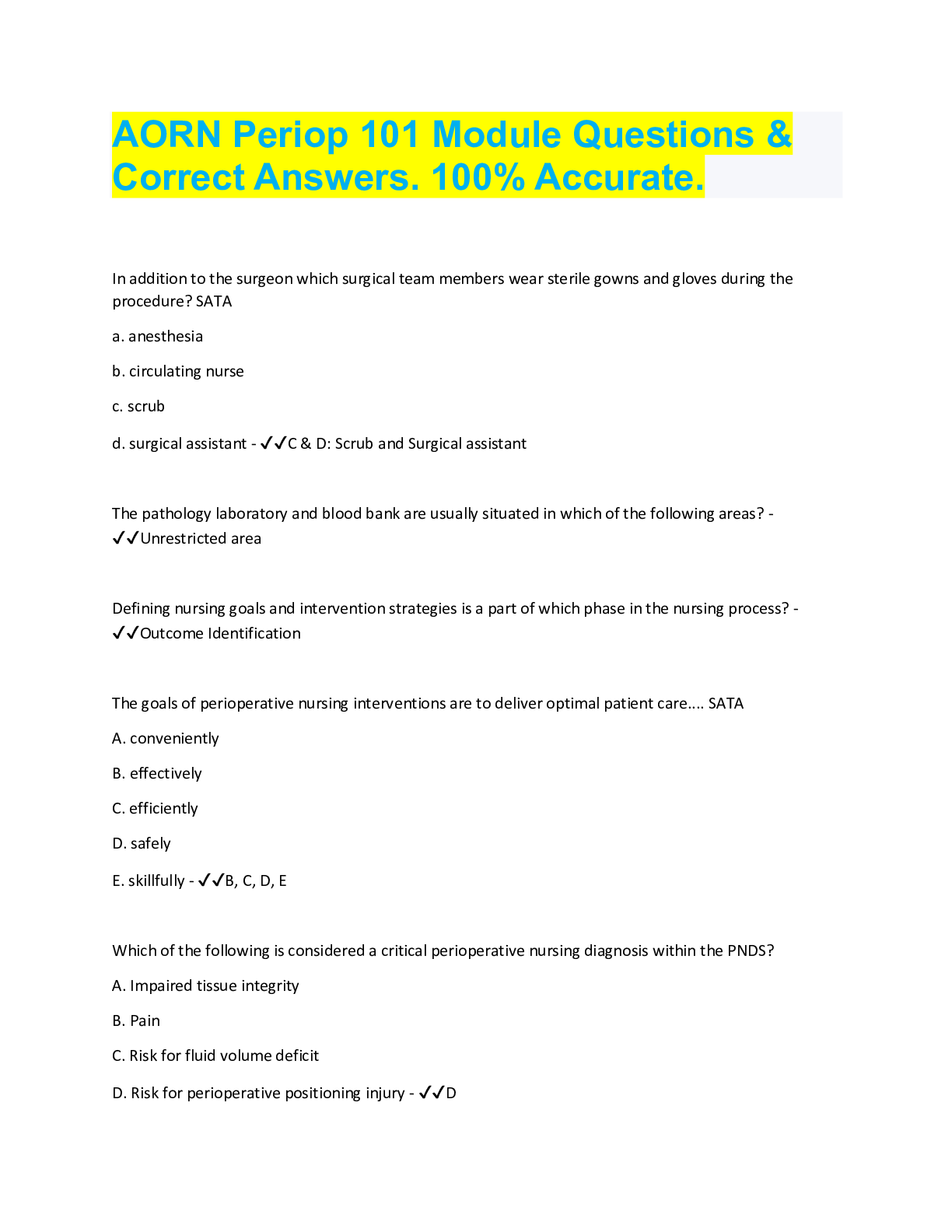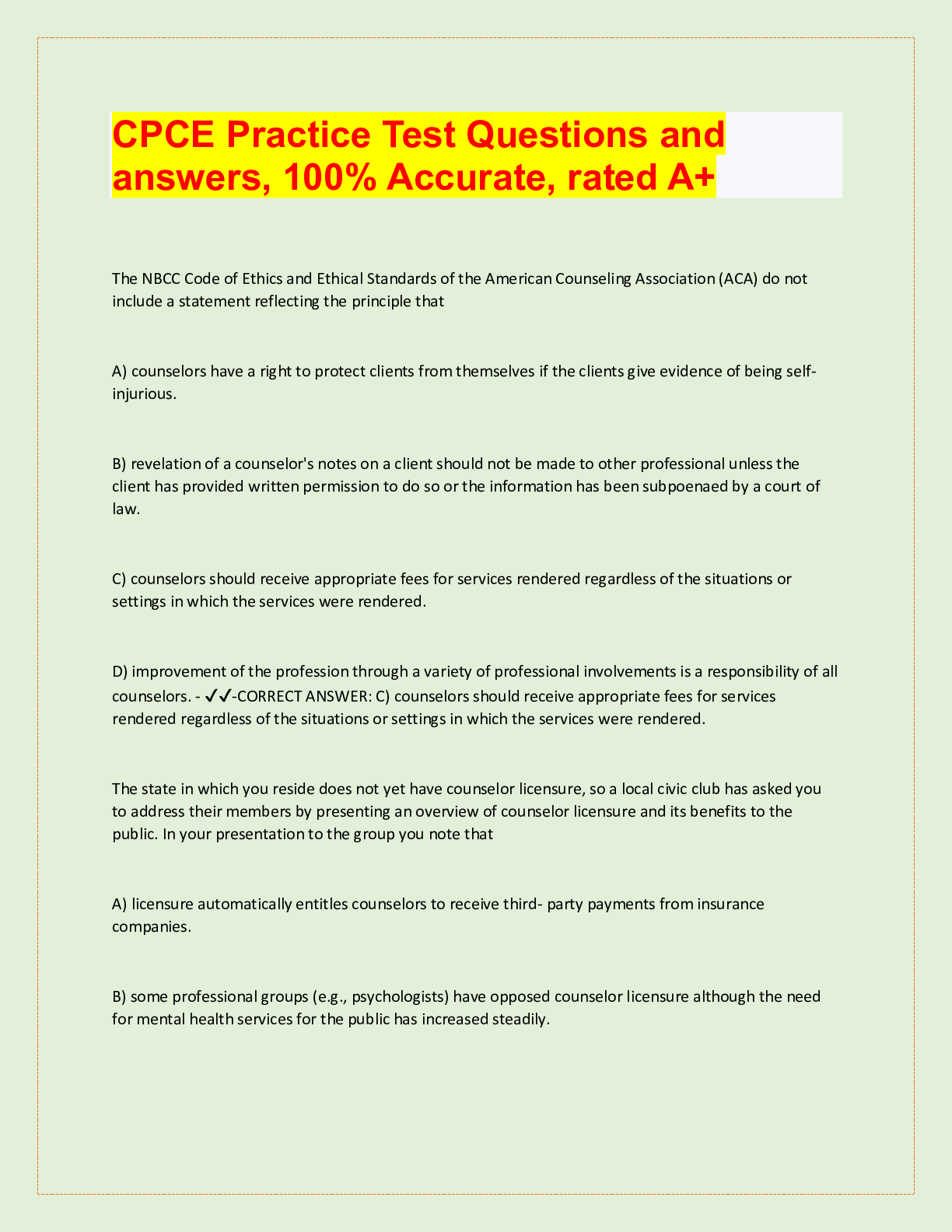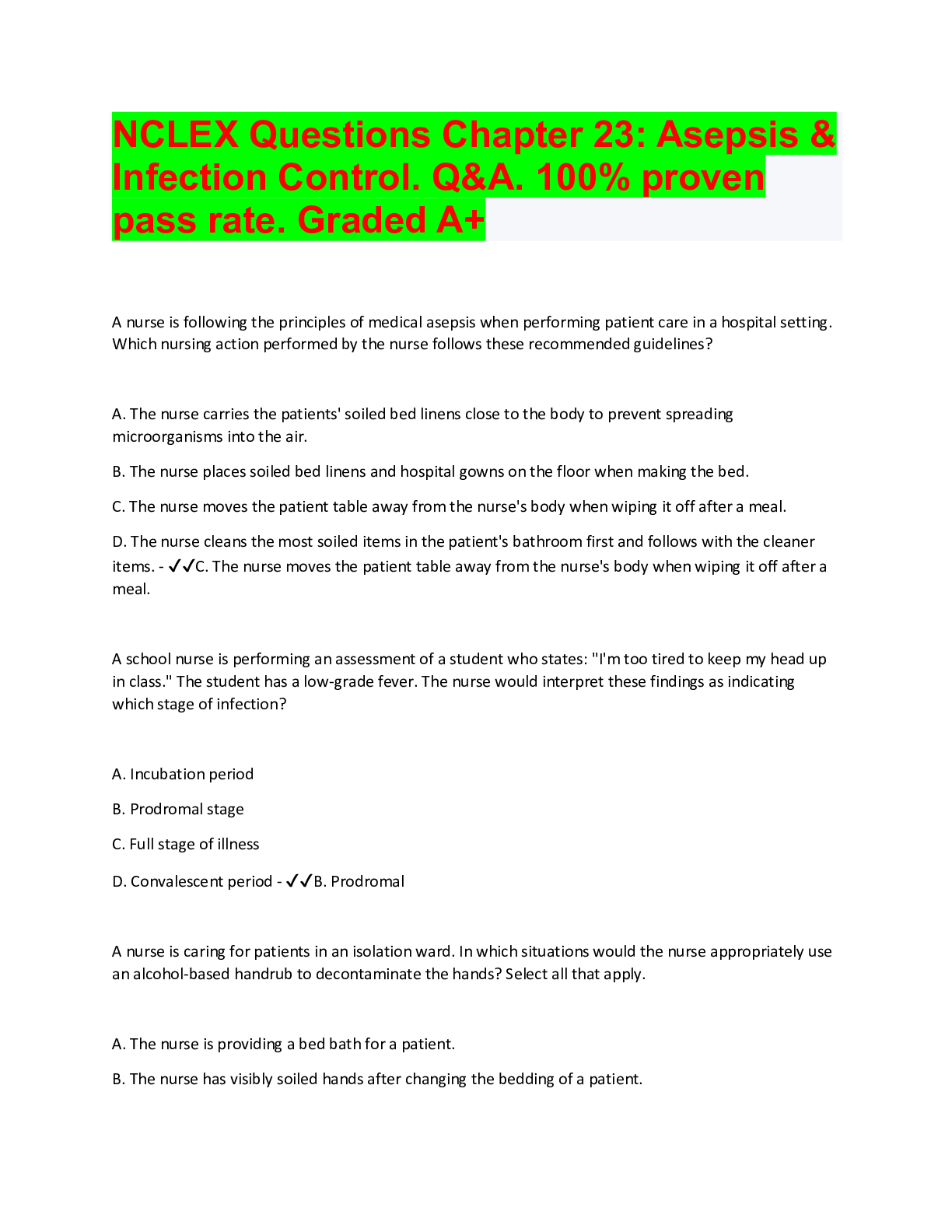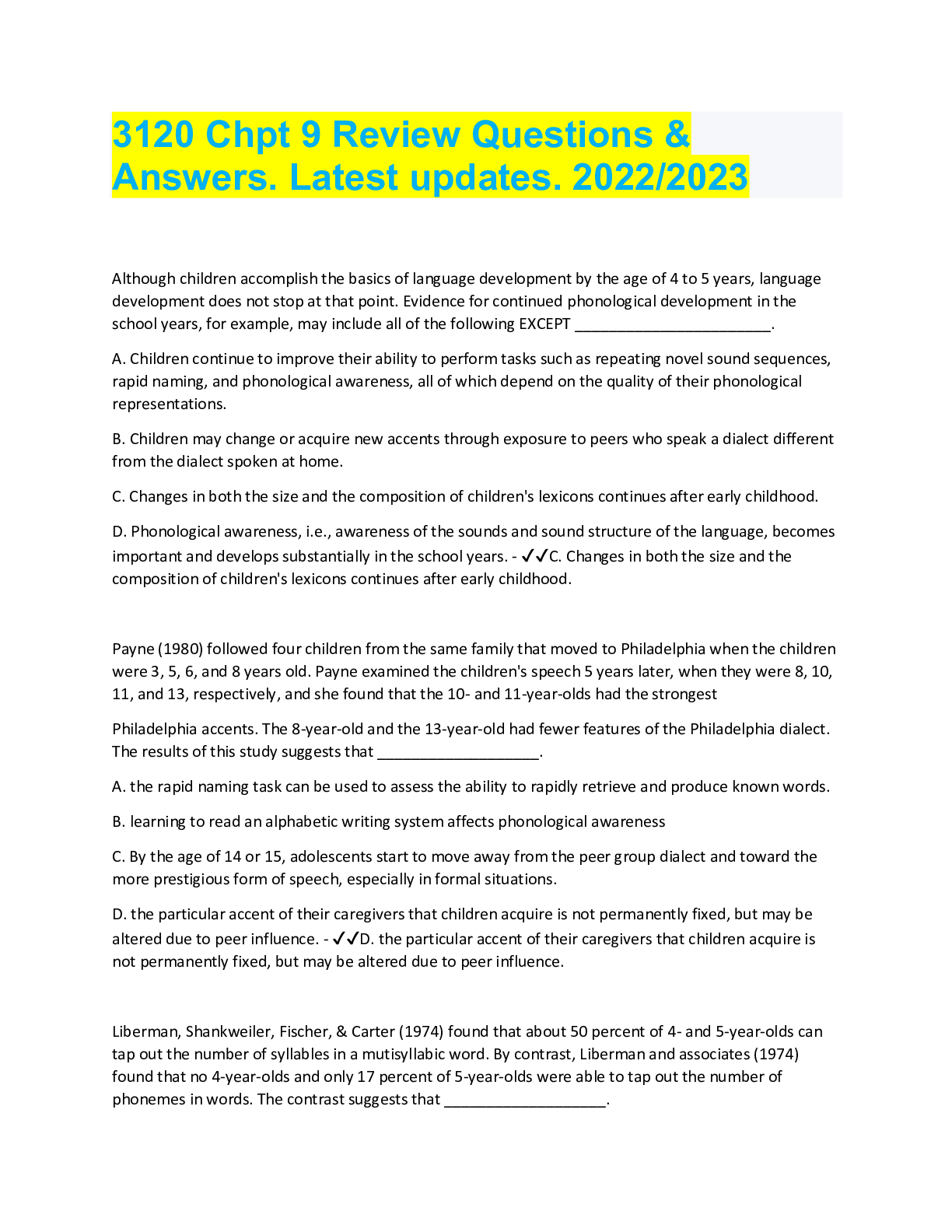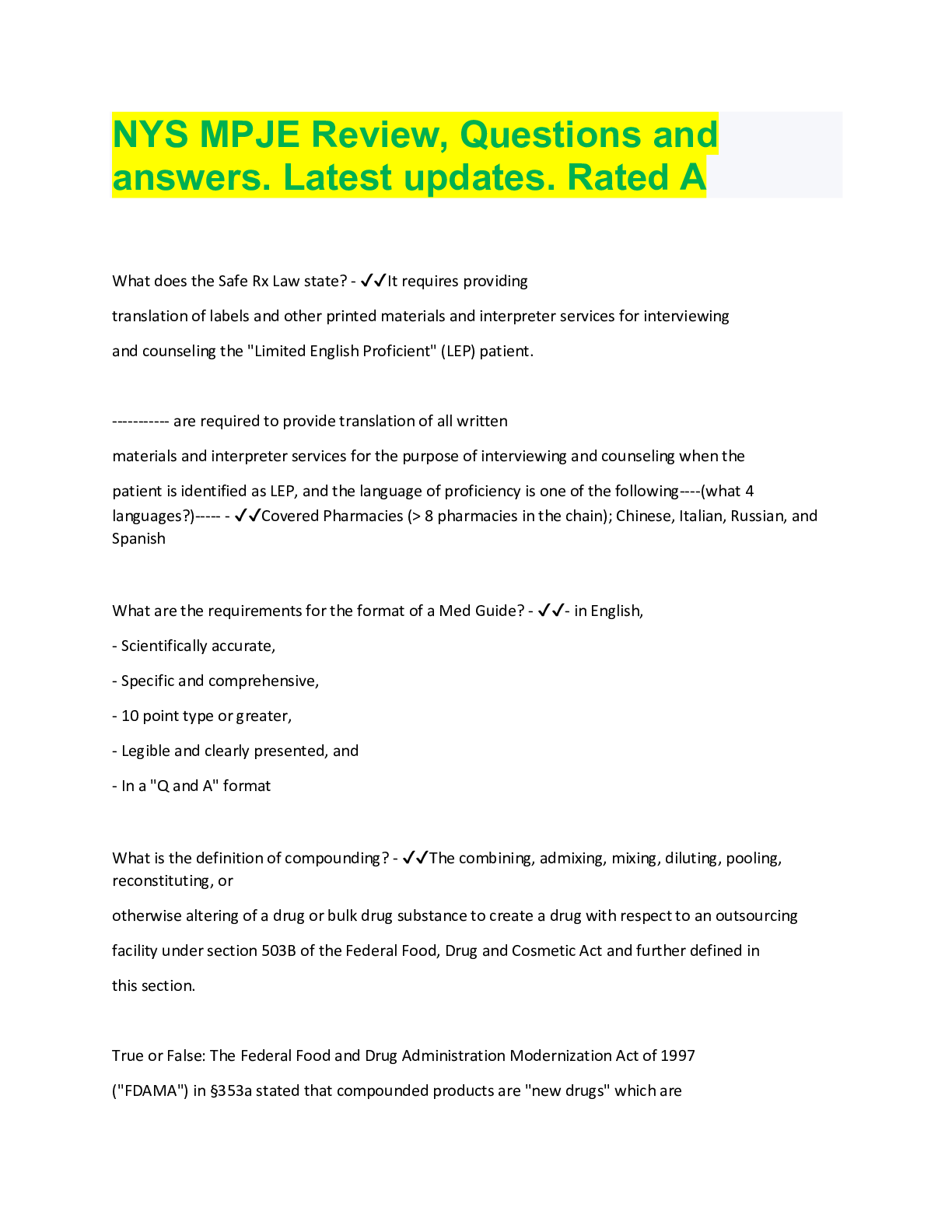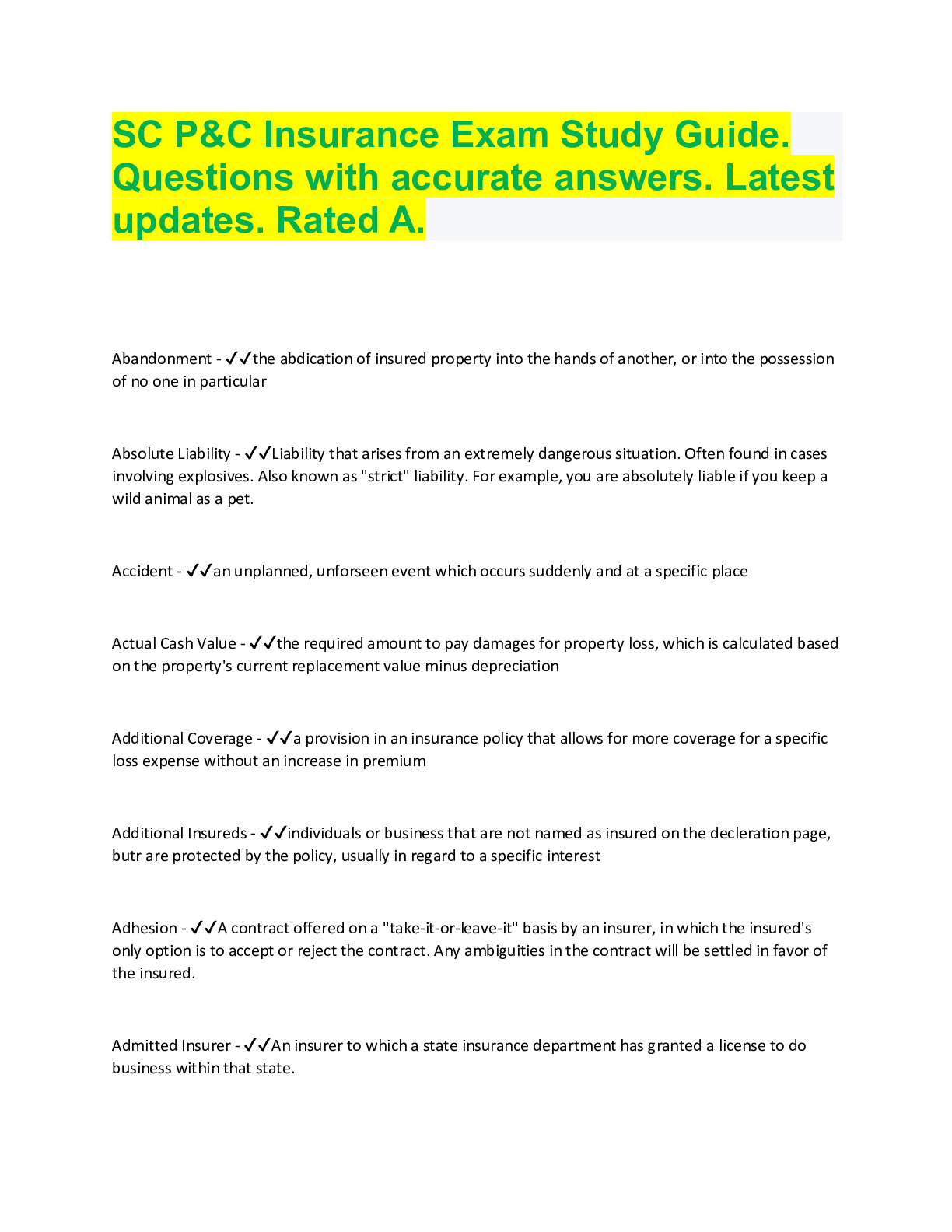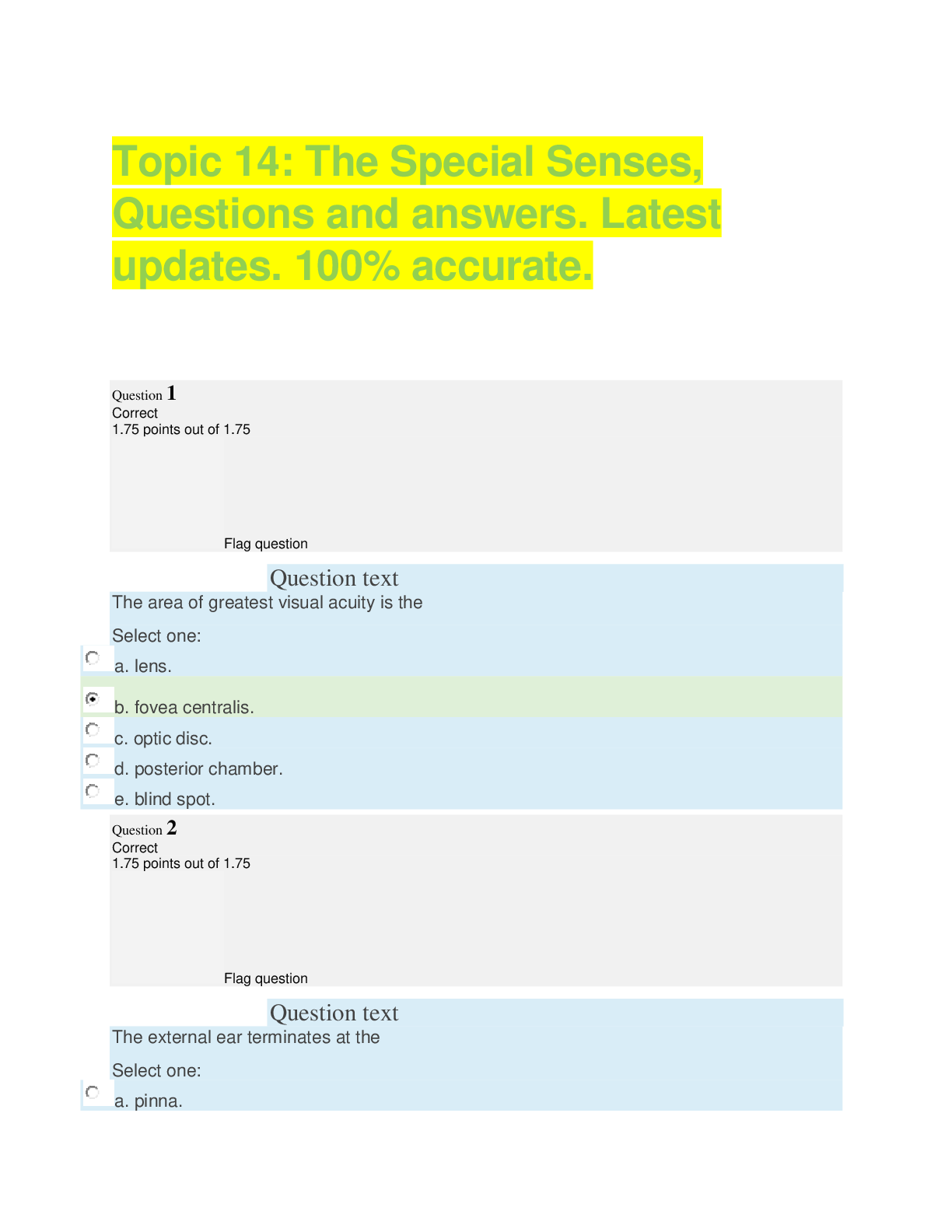*NURSING > QUESTIONS & ANSWERS > VATI - Fundamentals - Safety & Infection control Quiz with accurate answers. Latest updates. 2022/20 (All)
VATI - Fundamentals - Safety & Infection control Quiz with accurate answers. Latest updates. 2022/2023
Document Content and Description Below
VATI - Fundamentals - Safety & Infection control Quiz with accurate answers. Latest updates. 2022/2023 A client has a new tracheostomy. Which of the following interventions should the nurse inclu... de when performing tracheostomy care? Select one: a. Change tracheostomy ties when soiled. b. Clean disposable inner cannula with hydrogen peroxide. c. Suction the tracheostomy before beginning care. d. Remove soiled dressing with sterile gloves. - ✔✔a. Change tracheostomy ties when soiled. Raitonale: Tracheostomy ties should be changed once a day or when soiled. Secure new ties in place before removing old soiled ones to prevent accidental decannulation. One or two fingers should be able to be placed between the tie tape and the neck. A client has fallen in the bathroom. Which of the following is the priority nursing action? Select one: a. Assist the client back to bed b. Assess the client's level of consciousness c. Notify the healthcare provider d. Obtain the client's vital signs - ✔✔b. Assess the client's level of consciousness Rationale: Safety first. Before proceeding with the assessment or taking vital signs assess the level of consciousness. Complaints of pain, any joint or bone deformity may provide evidence of fractures or dislocations. Inspection of the skin will determine lacerations, contusions, or hematomas that may need to be treated. After a report to the provider, additional x-rays or exams may be ordered. A nurse is providing discharge education for a female client diagnosed with Chlamydia. Which statement made by the client would indicate the need for further instruction? Select one: a. "I will return to the clinic in one month for re-screening." b. "Symptoms of reinfection may include yellow vaginal discharge." c. "Possible complications to monitor for include pelvic inflammatory disease." d. "I will refrain from sexual intercourse until completion of antibiotics." - ✔✔a. "I will return to the clinic in one month for re-screening." Rationale: No test for cure is required, but all women should be rescreened for re-infections 3 to 12 months after treatment because of high risk for pelvic inflammatory disease (PID). There is less evidence of the need for re-screening of treated men, but it should be considered. A nurse is caring for a client with a diagnosis of sepsis with a temperature of 40.8 C (105.5 F). The provider has ordered a cooling blanket. Which intervention is appropriate to delegate to an Unlicensed Assistive Personnel (UAP)? Select one: a. Bathe the client to keep the skin damp b. Obtain a fan for the client's use c. Assess the client's skin for any reddened d. Report shivering by the client - ✔✔d. Report shivering by the client Rationale: The unlicensed assistive personnel should be taught to observe for and report shivering during any form of external cooling. Shivering may indicate that the client is being cooled too quickly. A nurse is triaging clients following a mass casualty event. The nurse should place a client who has sustained fatal injuries in which of the following triage categories? Select one: a. Emergent Category (Class I) b. Urgent Category (Class II) c. Nonurgent Category (Class III) d. Expectant Category (Class IV) - ✔✔d. Expectant Category (Class IV) Rationale: Class IV (Expectant Category) is reserved for clients who are not expected to live and will be allowed to die naturally. Comfort measures may be provided, but restorative care will not. These clients are the lowest priority when a mass casualty has occurred. A nurse is positioning a client for a urinary catheterization. Which of the following nursing actions would be best in preventing musculoskeletal injuries during the procedure? Select one: a. Using the non-dominant hand to insert the catheter. b. Raising the bed to a comfortable height. c. Positioning the client using a draw sheet. d. Narrowing the base of support. - ✔✔b. Raising the bed to a comfortable height. Rationale: Working with the bed at a comfortable height is more ergonomically appropriate to prevent back strain and possible injury, to prevent bending and/or twisting from the waist. A nurse is caring for an older adult client with delirium. Which intervention will most effectively reduce the client's risk for falls? Select one: a. Use of a night-light. b. Place bedside table in close proximity. c. Hourly rounding by the nurse. d. Demonstrate how to use the call light. - ✔✔c. Hourly rounding by the nurse. Rationale: In the health care environment, hourly rounding by nurses significantly reduces the occurrence of client falls, as well as reducing call light usage and increasing client satisfaction. A fire in a first floor operating room is forcing evacuation of clients from a second floor unit to another building. Which of the following clients would have the highest priority for the charge nurse to evacuate? Select one: a. A client semi-comatose after a cerebrovascular accident with an indwelling urinary catheter. b. A client receiving IV antibiotics every six hours for a leg ulcer. c. A client admitted with pancreatitis with nasogastric tube and PCA pump in place. d. A client post left hip replacement of two days ago whose daughter is visiting. - ✔✔b. A client receiving IV antibiotics every six hours for a leg ulcer. Rationale: The client with a leg ulcer can walk unassisted without an IV pole. In a hospital evacuation, unlike triage and evacuation outside of the hospital, the most stable, ambulatory clients will be evacuated first, followed by those who need assistance with mobility (wheelchairs) or equipment (tubes, catheters), and finally those who need to be moved by stretcher or in their hospital beds. The prevailing concept is to move as many clients as quickly and safely as possible from the area. A nurse is providing the family of a client with acquired immunodeficiency syndrome (AIDS) education in preparation for discharge. A family member asks about appropriate clean up of blood or body fluids. Which of the following is the correct response by the nurse? Select one: a. Disinfect the area with a 10% bleach solution after initial cleaning. b. Clean the area with soap and water and rinse thoroughly with ammonia. c. Disinfect the area with 70% isopropyl alcohol after initial cleaning. d. Use soap and water to clean, rinse thoroughly, and allow the area to air dry. - ✔✔a. Disinfect the area with a 10% bleach solution after initial cleaning. Rationale: A solution of 1 part bleach to 10 parts water (10% solution) is the disinfecting agent of choice after blood or body fluids are initially cleaned up and disposed of (at home in a sealed plastic bag and placed in the regular trash), and the area is initially cleansed with soap and water. A nurse is caring for a client when the IV infusion pump malfunctions and delivers 1 Liter of IV fluid over 2 hours. Which intervention is the priority? Select one: a. Monitor urine output. b. Fill out an incident report. c. Report the defective equipment. d. Document the amount of fluid infused. - ✔✔b. Fill out an incident report. Rationale: A malfunctioning device or product should be documented using an incident report. The report is confidential and separate from the medical record. It should never be documented in the client's medical record that an incident report was completed. A graduate nurse is caring for a client who is on neutropenic precautions. Which of the following actions by the nurse would require further teaching by the charge nurse? Select one: a. Discarding an empty blood bag and blood tubing in the client's beside trash can. b. Taking a blood pressure cuff to the bedside of a client on neutropenic precautions. c. Disposing of a used needle and syringe in the biohazard box in the client's room. d. Taking an infusion pump from the bedside of a client to the dirty utility room. - ✔✔a. Discarding an empty blood bag and blood tubing in the client's beside trash can. Rationale: The empty blood bag and tubing are considered to be biohazard waste and should be disposed of in a red bag or bin that will be incinerated rather than taken to a landfill. A newly-licensed nurse is preparing the surgical suite for a client who has a latex allergy. Which action demonstrates a need for further education? Select one: a. Placing monitoring devices in stockinet. b. Using glass syringes. c. Covering IV tubing ports with tape. d. Scheduling the case late in the day. - ✔✔d. Scheduling the case late in the day. Rationale: This action indicates a need for further education. Clients with latex allergy should be scheduled as the first case in the morning. This will allow latex dust (from the previous day) to be removed overnight. A nurse is orienting a newly licensed nurse to the operating room. Which of the following actions by the new nurse indicates a need for further education about surgical aseptic hand hygiene? Select one: a. Drying with a sterile towel moving from the hands to the elbows. b. Lathering hand and arms with soap to 5 cm (2 inches) above the elbows c. Rinsing hands and arms while keeping them lower than elbows. d. Cleaning under nails of both hands with a nail pick while under running water. - ✔✔c. Rinsing hands and arms while keeping them lower than elbows. Rationale: While rinsing removes transient bacteria from fingers, hands and forearms, keeping hands elevated above the elbows allows water to flow from least to most A client has just returned to the surgical unit after an open cholestectomy. A nurse notes the abdominal dressing is saturated with sanguineous drainage. Which of the following is the most appropriate intervention? Select one: a. Remove the dressing to assess the incision. b. Outline the drainage size with a marker. c. Reinforce the dressing with additional gauze. d. Document the assessment findings. - ✔✔c. Reinforce the dressing with additional gauze. Rationale: The appropriate intervention for a dressing that becomes wet from drainage is to reinforce the dressing by adding more dressing material to the existing dressing. The first dressing change is performed by the surgeon. The parents of an adolescent client ask the nurse why the meningiococcal conjugate vaccine is recommended before attending college. Which of the following statements best explains the reason why college-aged students should receive this vaccine? Select one: a. Living in a dormitory increases the risk of exposure to the disease. b. Upper respiratory infections are more common on college campuses. [Show More]
Last updated: 1 year ago
Preview 1 out of 15 pages
Instant download
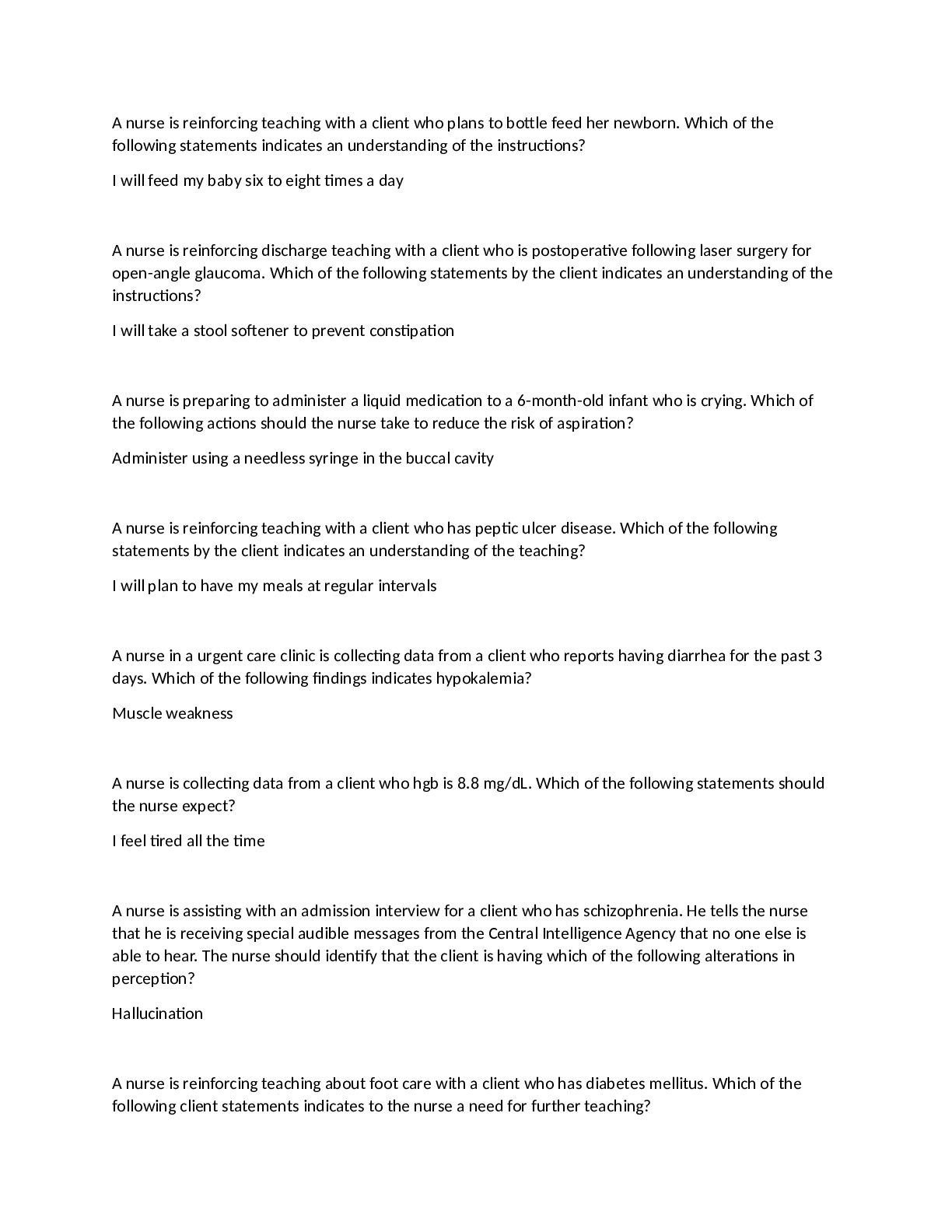
Buy this document to get the full access instantly
Instant Download Access after purchase
Add to cartInstant download
Reviews( 0 )
Document information
Connected school, study & course
About the document
Uploaded On
Oct 06, 2022
Number of pages
15
Written in
Additional information
This document has been written for:
Uploaded
Oct 06, 2022
Downloads
0
Views
72






